Analysis of the Impact of Landscape Patterns on Urban Heat Islands: A Case Study of Chengdu, China
Abstract
1. Introduction
2. Materials and Methods
2.1. Research Area and Data Source
2.2. Methods
2.2.1. Landscape Information Visualization Methods
2.2.2. Identification of Heat Islands Zone and Analysis of Space-Time Change
2.2.3. Spatial Correlation Analysis Method
3. Results and Analysis
3.1. Analysis of Landscape Area Changes
3.2. Analysis of Spatial Distribution and Temporal Changes in the Landscape Pattern Index
3.3. Analysis of Temporal and Spatial Change Trends of Heat Islands
3.4. Analysis of the Impact of Landscape Pattern Changes on the Heat Islands Effect
4. Discussion
5. Conclusions
Author Contributions
Funding
Institutional Review Board Statement
Informed Consent Statement
Data Availability Statement
Acknowledgments
Conflicts of Interest
References
- Lei, W.; Jiao, L.; Xu, G.; Zhou, Z. Urban scaling in rapidly urbanising China. Urban Stud. 2021, 59, 1889–1908. [Google Scholar] [CrossRef]
- United Nations. World Urbanization Prospects: The 2014 Revision, Highlights. United Nations, Department of Economic and Social Affairs, Population Division. (ST/ESA/SER.A/352). 2014. Available online: https://population.un.org/wup/ (accessed on 1 January 2019).
- Li, Z.; Zhong, J.; Yang, J.; Zhang, D.; He, S. Assessment framework and empirical analysis of the ecological protection importance for key town agglomerations in China. J. Clean. Prod. 2022, 372, 133682. [Google Scholar] [CrossRef]
- Howard, L. The Climate of London: Deduced from Meteorological Observations Made in the Metropolis and at Various Places around It; Palala Press: London, UK, 1833; Volume 3, p. 400. Available online: http://pi.lib.uchicago.edu/1001/cat/bib/4031709 (accessed on 25 September 2022).
- Manley, G. On the Frequency of Snow Fall in Metropolitan England. Quart. J. Roy Meteor. Soc. 1958, 84, 70–72. [Google Scholar] [CrossRef]
- Chakraborty, T.; Lee, X. Asimplified urban-extent algorithm to characterize surface urban heat islands on a global scale and examine vegetation control on their spatiotemporal variability. Int. J. Appl. Earth Obs. Geoinf. 2019, 74, 269–280. [Google Scholar] [CrossRef]
- Cheval, S.; Dumitrescu, A.; Irașoc, A.; Paraschiv, M.-G.; Perry, M.; Ghent, D. MODIS-based climatology of the Surface Urban Heat Island at country scale (Romania). Urban Clim. 2021, 41, 101056. [Google Scholar] [CrossRef]
- Li, Y.; Zhou, B.; Glockmann, M.; Kropp, J.P.; Rybski, D. Context sensitivity of surface urban heat island at the local and regional scales. Sustain. Cities Soc. 2021, 74, 103146. [Google Scholar] [CrossRef]
- He, B.-J.; Ding, L.; Prasad, D. Relationships among local-scale urban morphology, urban ventilation, urban heat island and outdoor thermal comfort under sea breeze influence. Sustain. Cities Soc. 2020, 60, 102289. [Google Scholar] [CrossRef]
- Yao, L.; Li, T.; Xu, M.; Xu, Y. How the landscape features of urban green space impact seasonal land surface temperatures at a city-block-scale: An urban heat island study in Beijing, China. Urban For. Urban Green. 2020, 52, 126704. [Google Scholar] [CrossRef]
- Oukawa, G.Y.; Krecl, P.; Targino, A.C. Fine-scale modeling of the urban heat island: A comparison of multiple linear regression and random forest approaches. Sci. Total Environ. 2022, 815, 152836. [Google Scholar] [CrossRef]
- Yan, C.; Guo, Q.; Li, H.; Li, L.; Qiu, G.Y. Quantifying the cooling effect of urban vegetation by mobile traverse method: A local-scale urban heat island study in a subtropical megacity. Build. Environ. 2020, 169, 106541. [Google Scholar] [CrossRef]
- Liu, L.; Lin, Y.; Liu, J.; Wang, L.; Wang, D.; Shui, T.; Chen, X.; Wu, Q. Analysis of local-scale urban heat island characteristics using an integrated method of mobile measurement and GIS-based spatial interpolation. Build. Environ. 2017, 117, 191–207. [Google Scholar] [CrossRef]
- Zhu, D.; Zhou, X.; Cheng, W. Water effects on urban heat islands in summer using WRF-UCM with gridded urban canopy parameters—A case study of Wuhan. Build. Environ. 2022, 225, 109528. [Google Scholar] [CrossRef]
- Liu, S.; Zhang, J.; Li, J.; Li, Y.; Zhang, J.; Wu, X. Simulating and mitigating extreme urban heat island effects in a factory area based on machine learning. Build. Environ. 2021, 202, 108051. [Google Scholar] [CrossRef]
- Jato-Espino, D.; Manchado, C.; Roldán-Valcarce, A.; Moscardó, V. ArcUHI: A GIS add-in for automated modelling of the Urban Heat Island effect through machine learning. Urban Clim. 2022, 44, 101203. [Google Scholar] [CrossRef]
- Demissie, B.; Amsalu, A.; Tesfamariam, Z.; Nyssen, J.; Meaza, H.; Asfaha, T.G.; Zenebe, A.; Gregoretti, C.; Van Eetvelde, V. Landscape Changes in the Semi-closed Raya Agricultural Graben Floor of Northern Ethiopia. Earth Syst. Environ. 2022, 6, 453–468. [Google Scholar] [CrossRef]
- Jia, Y.; Tang, L.; Xu, M.; Yang, X. Landscape pattern indices for evaluating urban spatial morphology—A case study of Chinese cities. Ecol. Indic. 2018, 99, 27–37. [Google Scholar] [CrossRef]
- Ward, K.; Lauf, S.; Kleinschmit, B.; Endlicher, W. Heat waves and urban heat islands in Europe: A review of relevant drivers. Sci. Total Environ. 2016, 569–570, 527–539. [Google Scholar] [CrossRef] [PubMed]
- Cao, X.; Onishi, A.; Chen, J.; Imura, H. Quantifying the cool island intensity of urban parks using ASTER and IKONOS data. Landsc. Urban Plan. 2010, 96, 224–231. [Google Scholar] [CrossRef]
- Shukla, A.; Jain, K. Critical analysis of spatial-temporal morphological characteristic of urban landscape. Arab. J. Geosci. 2019, 12, 112. [Google Scholar] [CrossRef]
- Liu, T.; Yang, X. Monitoring land changes in an urban area using satellite imagery, GIS and landscape metrics. Appl. Geogr. 2015, 56, 42–54. [Google Scholar] [CrossRef]
- Li, X.; Zhou, W.; Ouyang, Z. Relationship between land surface temperature and spatial pattern of greenspace: What are the effects of spatial resolution? Landsc. Urban Plan. 2013, 114, 1–8. [Google Scholar] [CrossRef]
- Zhou, W.; Huang, G.; Cadenasso, M.L. Does spatial configuration matter? Understanding the effects of land cover pattern on land surface temperature in urban landscapes. Landsc. Urban Plan. 2011, 102, 54–63. [Google Scholar] [CrossRef]
- Peng, J.; Xie, P.; Liu, Y.; Ma, J. Urban thermal environment dynamics and associated landscape pattern factors: A case study in the Beijing metropolitan region. Remote Sens. Environ. 2016, 173, 145–155. [Google Scholar] [CrossRef]
- Tepanosyan, G.; Muradyan, V.; Hovsepyan, A.; Pinigin, G.; Medvedev, A.; Asmaryan, S. Studying spatial-temporal changes and relationship of land cover and surface Urban Heat Island derived through remote sensing in Yerevan, Armenia. Build. Environ. 2020, 187, 107390. [Google Scholar] [CrossRef]
- Pramanik, S.; Punia, M. Land use/land cover change and surface urban heat island intensity: Source–sink landscape-based study in Delhi, India. Environ. Dev. Sustain. 2020, 22, 7331–7356. [Google Scholar] [CrossRef]
- Wang, F.; Niu, Z.G.; Pan-Pan, X.U. Seasonal variation of the surface thermal environment in changshu city based on landscape pattern. Chin. J. Ecol. 2016, 35, 3404–3412. Available online: http://www-webofscience-com-s.vpn.cdut.edu.cn:8118/wos/alldb/full-record/CSCD:5867973 (accessed on 25 September 2022).
- Dong, H. Spatial-temporal analysis of urban thermal environment and thermal landscape in suqian city. Geospat. Inf. 2016, 14, 31–34. Available online: http://en.cnki.com.cn/Article_en/CJFDTOTAL-DXKJ201605010.htm (accessed on 25 September 2022).
- Chen, A.L.; Sun, R.H.; Chen, L.D. Studies on urban heat island from a landscape pattern view: A review. Acta Ecol. Sin. 2012, 32, 4553–4565. Available online: http://www-webofscience-com-s.vpn.cdut.edu.cn:8118/wos/alldb/full-record/CSCD:4605540 (accessed on 25 September 2022). [CrossRef]
- Nastran, M.; Kobal, M.; Eler, K. Urban heat islands in relation to green land use in European cities. Urban For. Urban Green. 2019, 37, 33–41. [Google Scholar] [CrossRef]
- Feyisa, G.L.; Dons, K.; Meilby, H. Efficiency of parks in mitigating urban heat island effect: An example from Addis Ababa. Landsc. Urban Plan. 2014, 123, 87–95. [Google Scholar] [CrossRef]
- Hamada, S.; Ohta, T. Seasonal variations in the cooling effect of urban green areas on surrounding urban areas. Urban For. Urban Green. 2010, 9, 15–24. [Google Scholar] [CrossRef]
- Li, J.; Song, C.; Cao, L.; Zhu, F.; Meng, X.; Wu, J. Impacts of landscape structure on surface urban heat islands: A case study of Shanghai, China. Remote Sens. Environ. 2011, 115, 3249–3263. [Google Scholar] [CrossRef]
- Maimaitiyiming, M.; Ghulam, A.; Tiyip, T.; Pla, F.; Latorre-Carmona, P.; Halik, Ü.; Sawut, M.; Caetano, M. Effects of green space spatial pattern on land surface temperature: Implications for sustainable urban planning and climate change adaptation. Isprs J. Photogramm. Remote Sens. 2014, 89, 59–66. [Google Scholar] [CrossRef]
- Chang, C.-R.; Li, M.-H.; Chang, S.-D. A preliminary study on the local cool-island intensity of Taipei city parks. Landsc. Urban Plan. 2007, 80, 386–395. [Google Scholar] [CrossRef]
- Dugord, P.-A.; Lauf, S.; Schuster, C.; Kleinschmit, B. Land use patterns, temperature distribution, and potential heat stress risk—The case study Berlin, Germany. Comput. Environ. Urban Syst. 2014, 48, 86–98. [Google Scholar] [CrossRef]
- Masoudi, M.; Tan, P.Y. Multi-year comparison of the effects of spatial pattern of urban green spaces on urban land surface temperature. Landsc. Urban Plan. 2019, 184, 44–58. [Google Scholar] [CrossRef]
- Zullo, F.; Fazio, G.; Romano, B.; Marucci, A.; Fiorini, L. Effects of urban growth spatial pattern (UGSP) on the land surface temperature (LST): A study in the Po Valley (Italy). Sci. Total Environ. 2019, 650, 1740–1751. [Google Scholar] [CrossRef]
- Huang, C.; Yang, J.; Lu, H.; Huang, H.; Yu, L. Green Spaces as an Indicator of Urban Health: Evaluating Its Changes in 28 Mega-Cities. Remote Sens. 2017, 9, 1266. [Google Scholar] [CrossRef]
- Gumma, M.K.; Mohammad, I.; Nedumaran, S.; Whitbread, A.; Lagerkvist, C.J. Urban Sprawl and Adverse Impacts on Agricultural Land: A Case Study on Hyderabad, India. Remote Sens. 2017, 9, 1136. [Google Scholar] [CrossRef]
- Yang, C.B.; Zhang, S.W.; He, X.Y. Estimation of the relationship between urban heat island and land surface factors using Landsat8 data: A case study in Changchun, China. Arid Land Resour. Environ. 2016, 30, 110–115. Available online: http://www-webofscience-com-s.vpn.cdut.edu.cn:8118/wos/alldb/full-record/CSCD:5874723 (accessed on 25 September 2022).
- Geospatial Data Cloud. Available online: http://www.gscloud.cn (accessed on 9 September 2018).
- Zheng, X.; Fu, M.C.; Yao, H. Landscape Pattern Spatial Analysis Technology and Its Application; Science Press: Beijing, China, 2010; p. 50. [Google Scholar]
- McGarigal, K.; Cushman, S.A.; Ene, E. FRAGSTATS v4: Spatial Pattern Analysis Program for Categorical and Continuous Maps. Computer Software Program Produced by the Authors at the University of Massachusetts, Amherst. 2012. Available online: http://www.umass.edu/landeco/research/fragstats/fragstats.html (accessed on 9 September 2018).
- Cristóbal, J.; Jiménez-Muñoz, J.C.; Prakash, A.; Mattar, C.; Skoković, D.; Sobrino, J.A. An Improved Single-Channel Method to Retrieve Land Surface Temperature from the Landsat-8 Thermal Band. Remote Sens. 2018, 10, 431. [Google Scholar] [CrossRef]
- Fu, Y.; Guo, Q.; Wu, X.; He, C.; Sang, X.; Xie, T. A modified model of surface temperature inversion based on Landsat 8 remote-sensing data and measured data. Int. J. Remote Sens. 2018, 39, 6170–6181. [Google Scholar] [CrossRef]
- Jiménez, C.; Prigent, C.; Ermida, S.L.; Moncet, J.-L. Inversion of AMSR-E observations for land surface temperature estimation: 1. Methodology and evaluation with station temperature. J. Geophys. Res. Atmos. 2017, 122, 3330–3347. [Google Scholar] [CrossRef]
- Liu, L.; Zhang, Y. Urban Heat Island Analysis Using the Landsat TM Data and ASTER Data: A Case Study in Hong Kong. Remote Sens. 2011, 3, 1535–1552. [Google Scholar] [CrossRef]
- Wang, S.; Ma, Q.; Ding, H.; Liang, H. Detection of urban expansion and land surface temperature change using multi-temporal landsat images. Resour. Conserv. Recycl. 2018, 128, 526–534. [Google Scholar] [CrossRef]
- Lu, Y.; He, T.; Xu, X.; Qiao, Z. Investigation the Robustness of Standard Classification Methods for Defining Urban Heat Islands. IEEE J. Sel. Top. Appl. Earth Obs. Remote Sens. 2021, 14, 11386–11394. [Google Scholar] [CrossRef]
- Anselin, L.; Syabri, I.; Smirnov, O. Visualizing Multivariate Spatial Correlation with Dynamically Linked Windows. In Proceedings of the CSISS Workshop on New Tools for Spatial Data Analysis, Santa Barbara, CA, USA, 1 January 2002; Available online: http://citeseer.ist.psu.edu/544470.html (accessed on 25 September 2022).
- Zhang, Y.; Liu, Y.; Zhang, Y.; Liu, Y.; Zhang, G.; Chen, Y. On the spatial relationship between ecosystem services and urbanization: A case study in Wuhan, China. Sci. Total Environ. 2018, 637–638, 780–790. [Google Scholar] [CrossRef]
- Wu, Y.; Hou, H.; Wang, R.; Murayama, Y.; Wang, L.; Hu, T. Effects of landscape patterns on the morphological evolution of surface urban heat island in Hangzhou during 2000–2020. Sustain. Cities Soc. 2022, 79, 103717. [Google Scholar] [CrossRef]
- Wang, L.; Hou, H.; Weng, J. Ordinary least squares modelling of urban heat island intensity based on landscape composition and configuration: A comparative study among three megacities along the Yangtze River. Sustain. Cities Soc. 2020, 62, 102381. [Google Scholar] [CrossRef]
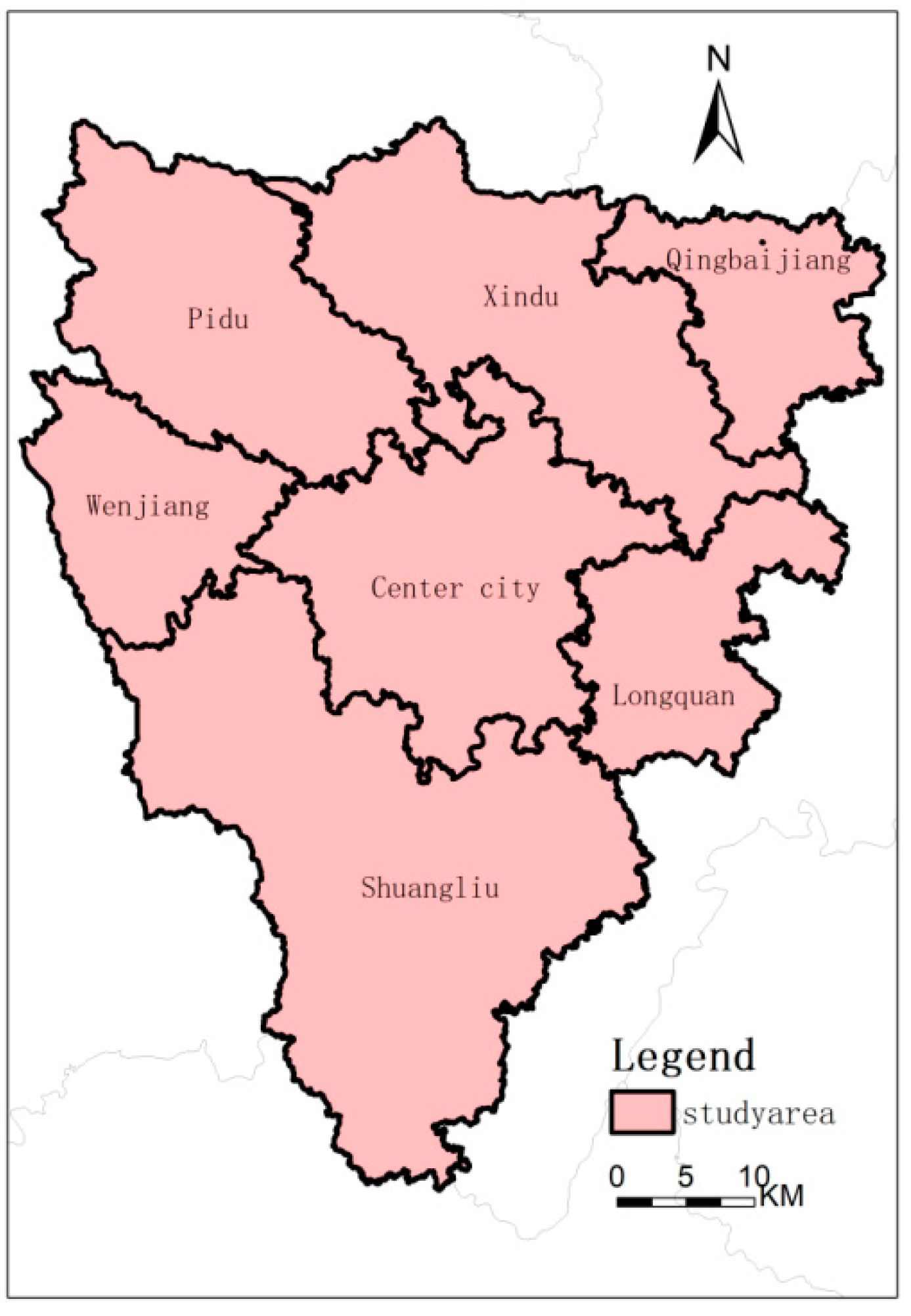
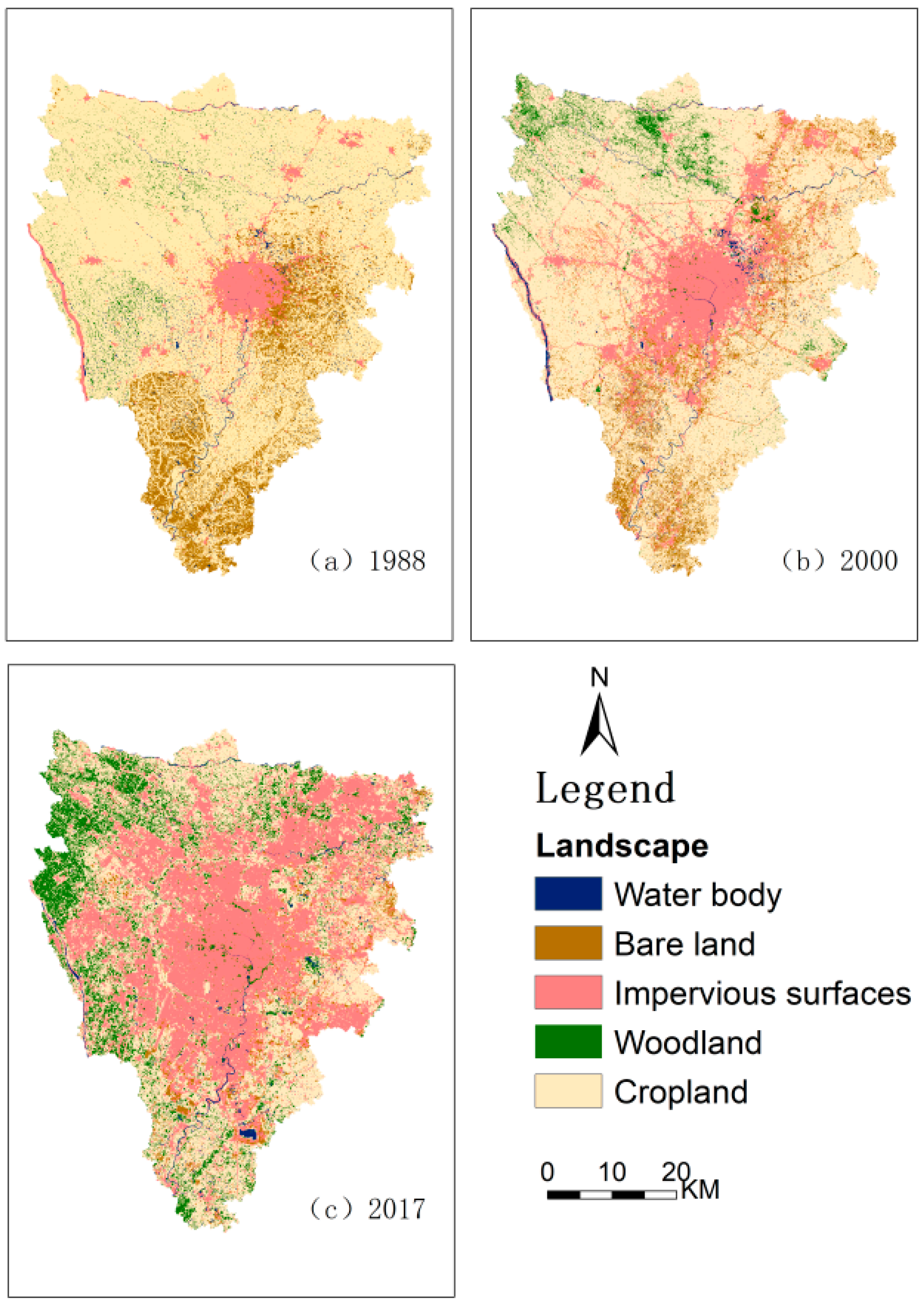
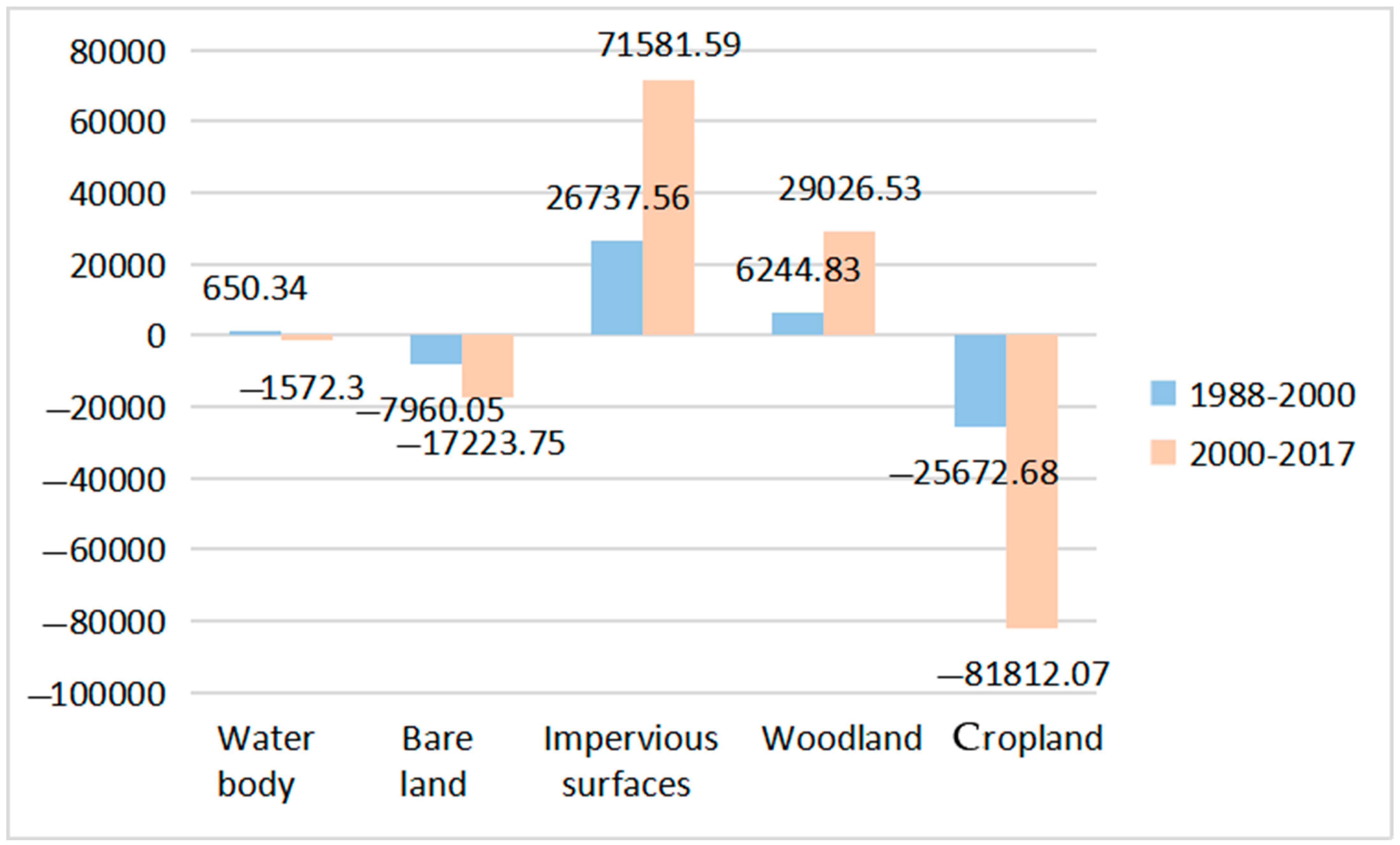
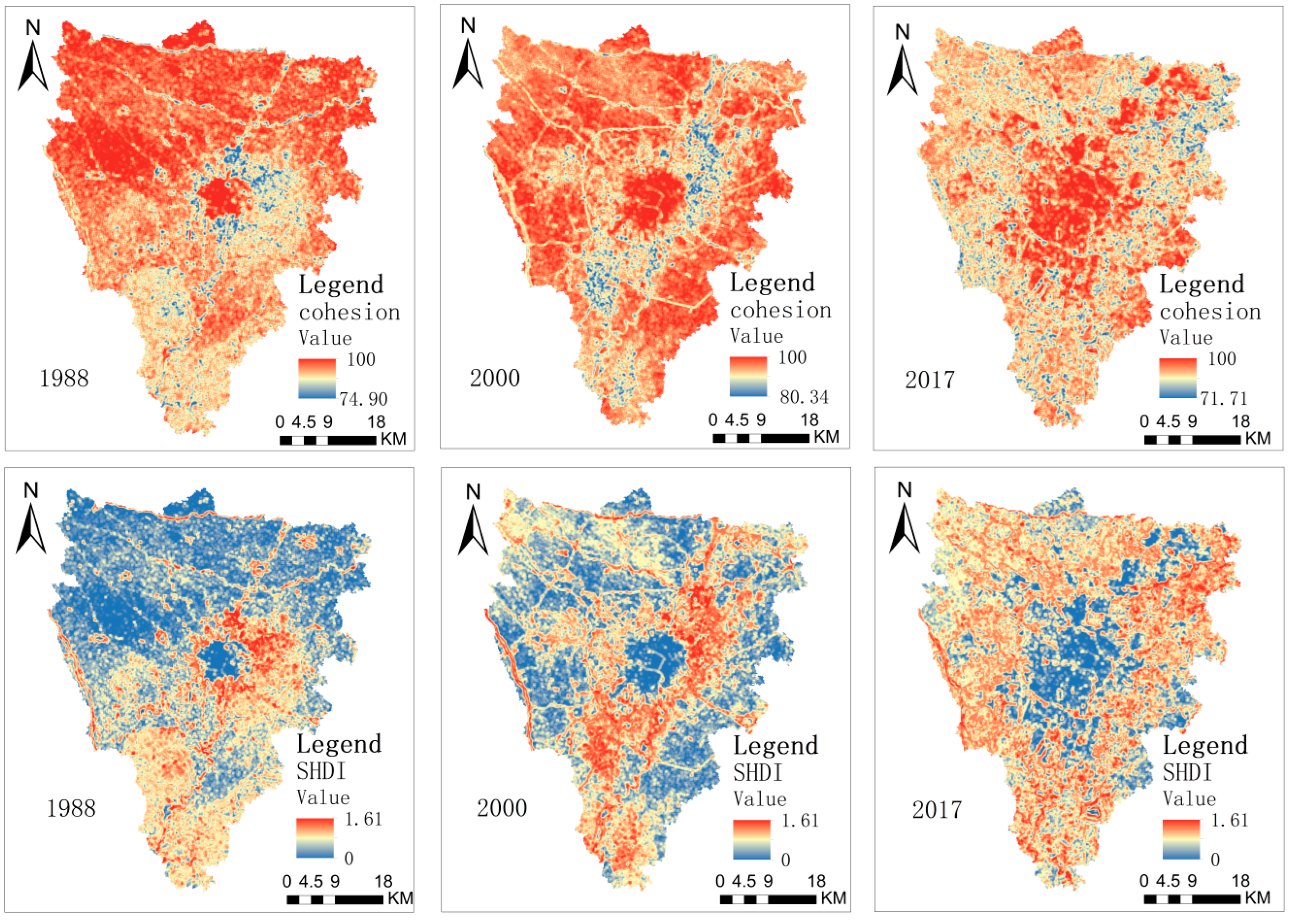
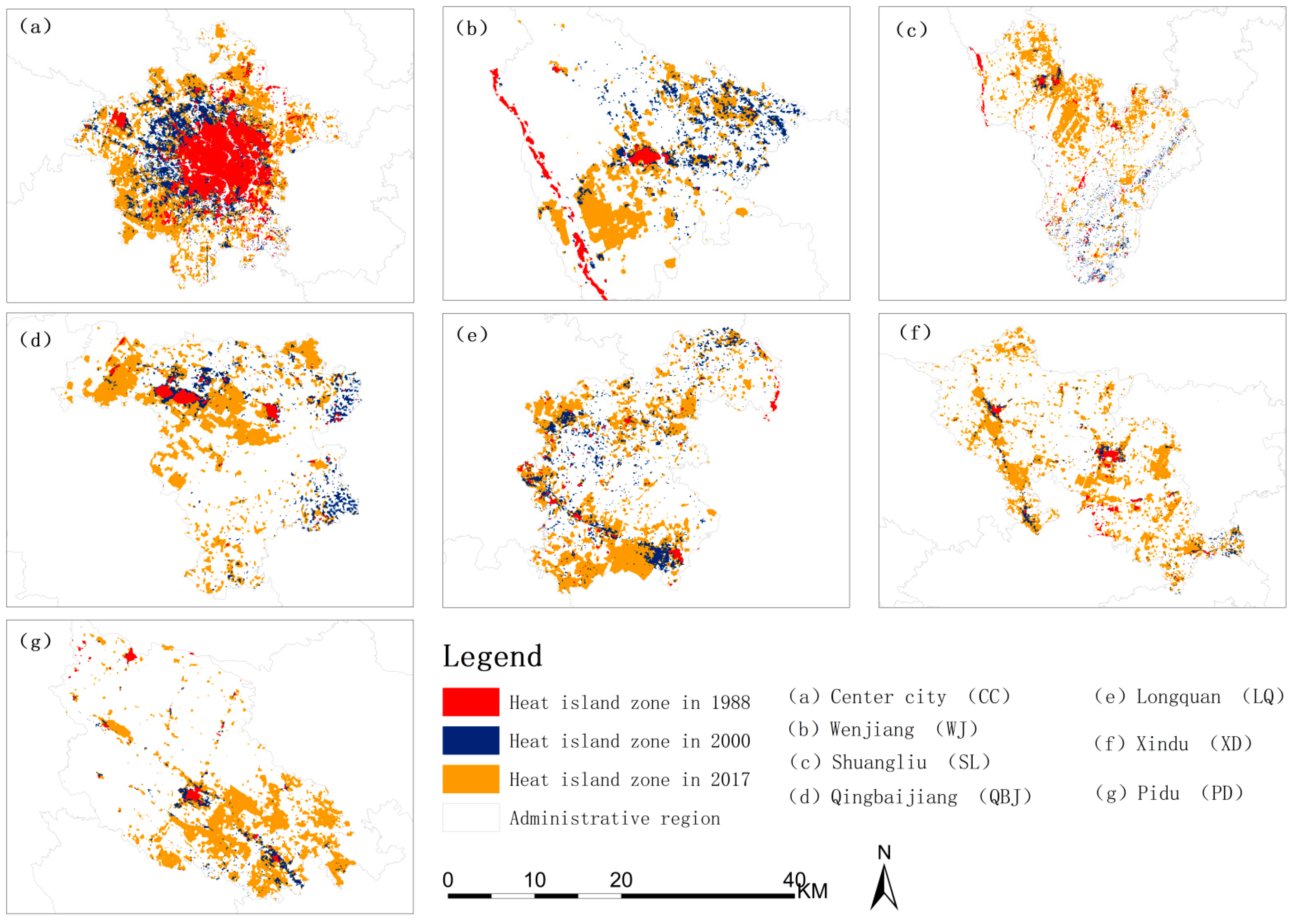
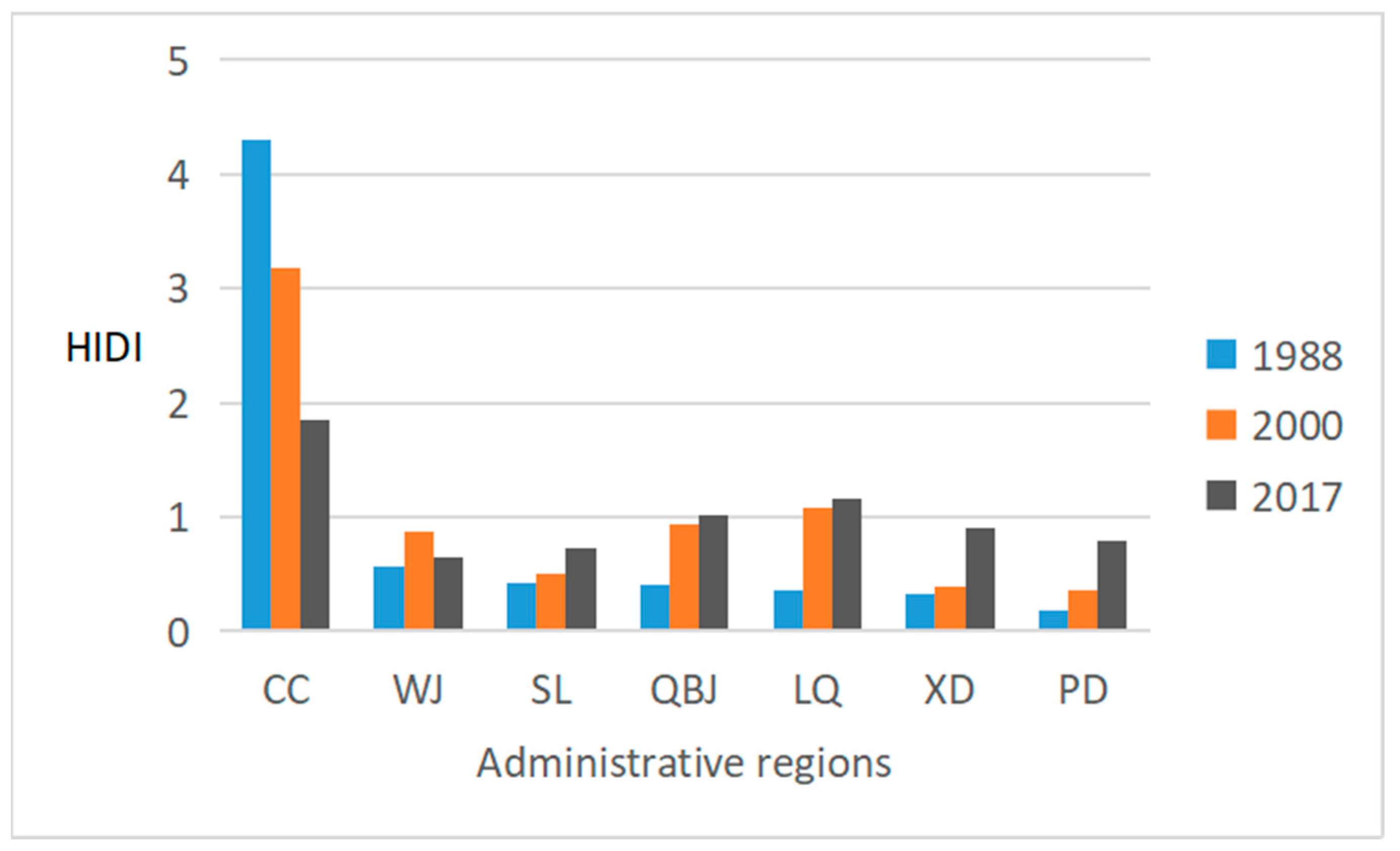

| Time | 1988 | 2000 | 2017 | A (1988–2000) Change | B (2000–2017) Change | ||
|---|---|---|---|---|---|---|---|
| Zone | Heat islands area (ha) | Area (ha) | % | Area (ha) | % | ||
| CC | 8804.25 | 11,013.12 | 22,781.61 | 2208.87 | 25.09 | 11,768.49 | 106.86 |
| QBJ | 384.21 | 1472.04 | 5635.71 | 1087.83 | 283.13 | 4163.67 | 282.85 |
| XD | 699.57 | 1460.16 | 11,906.8 | 760.59 | 108.72 | 10,446.64 | 715.44 |
| PD | 345.78 | 1099.8 | 8742.51 | 754.02 | 218.06 | 7642.71 | 694.92 |
| WJ | 566.91 | 1473.84 | 3861.09 | 906.93 | 159.98 | 2387.25 | 161.97 |
| SL | 1565.91 | 3148.92 | 16,290.90 | 1583.01 | 101.09 | 13,141.98 | 417.35 |
| LQ | 376.83 | 1879.92 | 7203.96 | 1503.09 | 398.88 | 5324.04 | 283.21 |
| Total | 12,743.46 | 21,547.80 | 76,422.58 | 8804.34 | 69.09 | 54,874.78 | 254.67 |
| Landscape Index | Landscape Type | Moran’s I | p | Z |
|---|---|---|---|---|
| COHESION | Impervious surface | 0.47 | 0.001 | 259.12 |
| Barren | 0.17 | 0.001 | 51.93 | |
| Water body | −0.42 | 0.001 | −47.93 | |
| Woodland | −0.42 | 0.001 | −174.99 | |
| Cropland | −0.14 | 0.001 | −89.64 | |
| SPLIT | Impervious surface | −0.36 | 0.001 | −197.31 |
| Barren | −0.15 | 0.001 | −48.38 | |
| Water body | 0.34 | 0.001 | 40.21 | |
| Woodland | 0.37 | 0.001 | 155.79 | |
| Cropland | 0.13 | 0.001 | 80.54 | |
| PLAND | Impervious surface | 0.53 | 0.001 | 311.63 |
| Barren | 0.21 | 0.001 | 76.58 | |
| Water body | −0.48 | 0.001 | −64.99 | |
| Woodland | −0.52 | 0.001 | −232.90 | |
| Cropland | −0.14 | 0.001 | −111.33 |
Publisher’s Note: MDPI stays neutral with regard to jurisdictional claims in published maps and institutional affiliations. |
© 2022 by the authors. Licensee MDPI, Basel, Switzerland. This article is an open access article distributed under the terms and conditions of the Creative Commons Attribution (CC BY) license (https://creativecommons.org/licenses/by/4.0/).
Share and Cite
Sun, Z.; Li, Z.; Zhong, J. Analysis of the Impact of Landscape Patterns on Urban Heat Islands: A Case Study of Chengdu, China. Int. J. Environ. Res. Public Health 2022, 19, 13297. https://doi.org/10.3390/ijerph192013297
Sun Z, Li Z, Zhong J. Analysis of the Impact of Landscape Patterns on Urban Heat Islands: A Case Study of Chengdu, China. International Journal of Environmental Research and Public Health. 2022; 19(20):13297. https://doi.org/10.3390/ijerph192013297
Chicago/Turabian StyleSun, Zishu, Zhigang Li, and Jialong Zhong. 2022. "Analysis of the Impact of Landscape Patterns on Urban Heat Islands: A Case Study of Chengdu, China" International Journal of Environmental Research and Public Health 19, no. 20: 13297. https://doi.org/10.3390/ijerph192013297
APA StyleSun, Z., Li, Z., & Zhong, J. (2022). Analysis of the Impact of Landscape Patterns on Urban Heat Islands: A Case Study of Chengdu, China. International Journal of Environmental Research and Public Health, 19(20), 13297. https://doi.org/10.3390/ijerph192013297






